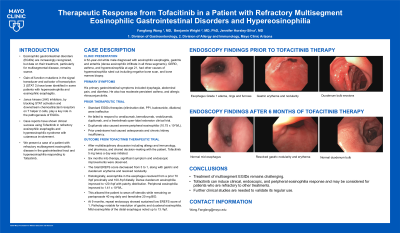Monday Poster Session
Category: Esophagus
P2317 - Therapeutic Response From Tofacitinib in a Patient with Refractory Multisegment Eosinophilic Gastrointestinal Disorders and Hypereosinophilia
Monday, October 28, 2024
10:30 AM - 4:00 PM ET
Location: Exhibit Hall E

Has Audio

Fangfang Wang, MD
Mayo Clinic Arizona
Scottsdale, AZ
Presenting Author(s)
Fangfang Wang, MD, Benjamin Wright, MD, Jennifer Horsley-Silva, MD
Mayo Clinic Arizona, Scottsdale, AZ
Introduction: Eosinophilic gastrointestinal disorders (EGIDs) are increasingly recognized, but data on their treatment, particularly for multisegmental disease, remains scarce. Gain-of-function mutations in the signal transducer and activator of transcription 3 (STAT 3) have been identified in some patients with hypereosinophilia and eosinophilic esophagitis. Janus kinase (JAK) inhibitors, by blocking STAT activation and downstream chemoattractant receptors on T helper 2 cells, play a key role in the pathogenesis of EGIDs. Case reports have shown clinical success using Tofacitinib in refractory eosinophilic esophagitis and hypereosinophilic syndrome with cutaneous involvement. We present a case of a patient with refractory multisegment eosinophilic disease in the gastrointestinal tract and hypereosinophilia responding to Tofacitinib.
Case Description/Methods: A 52-year-old white male diagnosed with eosinophilic esophagitis, gastritis and enteritis (dense eosinophilic infiltrate in all three segments), GERD, asthma, and hypereosinophilia at age 21, had other causes of hypereosinophilia ruled out. His primary symptoms included dysphagia, abdominal pain, and diarrhea. Complicated by protein-losing enteropathy and hypogammaglobulinemia. Systemic steroids for 20 years resulted in osteopenia and renal insufficiency. More common therapies EGIDs including elimination diet, PPI, budesonide, and dilation were ineffective, and he failed to respond to omalizumab, benralizumab, vedolizumab, dupilumab, and clinical trial with lirentelimab. Dupilumab also caused severe peripheral eosinophilia (10.75 x 10^9/L). After multidisciplinary discussion and shared decision-making, Tofacitinib 5 mg twice a day was initiated. Six months into therapy, significant symptom and endoscopic improvements were observed. The total EREFS score decreased from 3 to 1, along with gastric and duodenum erythema and resolved nodularity. Eosinophilia (eos) in the esophagus resolved from a prior 100 eos/hpf. Gastric single focus eos >30/hpf. Dense duodenum eos decreased to < 20 /hpf with patchy distribution. Peripheral eosinophilia improved to 1.41 x 10^9/L. This allowed the patient to wean off budesonide while remaining on pantoprazole 40 mg daily and famotidine 40 mg BID.
Discussion: Treatment of multisegment EGIDs remains challenging. Tofacitinib can induce clinical, endoscopic, and peripheral eosinophilia response and may be considered for patients refractory to other treatments. Further clinical studies are needed to validate its regular use.
Disclosures:
Fangfang Wang, MD, Benjamin Wright, MD, Jennifer Horsley-Silva, MD. P2317 - Therapeutic Response From Tofacitinib in a Patient with Refractory Multisegment Eosinophilic Gastrointestinal Disorders and Hypereosinophilia, ACG 2024 Annual Scientific Meeting Abstracts. Philadelphia, PA: American College of Gastroenterology.
Mayo Clinic Arizona, Scottsdale, AZ
Introduction: Eosinophilic gastrointestinal disorders (EGIDs) are increasingly recognized, but data on their treatment, particularly for multisegmental disease, remains scarce. Gain-of-function mutations in the signal transducer and activator of transcription 3 (STAT 3) have been identified in some patients with hypereosinophilia and eosinophilic esophagitis. Janus kinase (JAK) inhibitors, by blocking STAT activation and downstream chemoattractant receptors on T helper 2 cells, play a key role in the pathogenesis of EGIDs. Case reports have shown clinical success using Tofacitinib in refractory eosinophilic esophagitis and hypereosinophilic syndrome with cutaneous involvement. We present a case of a patient with refractory multisegment eosinophilic disease in the gastrointestinal tract and hypereosinophilia responding to Tofacitinib.
Case Description/Methods: A 52-year-old white male diagnosed with eosinophilic esophagitis, gastritis and enteritis (dense eosinophilic infiltrate in all three segments), GERD, asthma, and hypereosinophilia at age 21, had other causes of hypereosinophilia ruled out. His primary symptoms included dysphagia, abdominal pain, and diarrhea. Complicated by protein-losing enteropathy and hypogammaglobulinemia. Systemic steroids for 20 years resulted in osteopenia and renal insufficiency. More common therapies EGIDs including elimination diet, PPI, budesonide, and dilation were ineffective, and he failed to respond to omalizumab, benralizumab, vedolizumab, dupilumab, and clinical trial with lirentelimab. Dupilumab also caused severe peripheral eosinophilia (10.75 x 10^9/L). After multidisciplinary discussion and shared decision-making, Tofacitinib 5 mg twice a day was initiated. Six months into therapy, significant symptom and endoscopic improvements were observed. The total EREFS score decreased from 3 to 1, along with gastric and duodenum erythema and resolved nodularity. Eosinophilia (eos) in the esophagus resolved from a prior 100 eos/hpf. Gastric single focus eos >30/hpf. Dense duodenum eos decreased to < 20 /hpf with patchy distribution. Peripheral eosinophilia improved to 1.41 x 10^9/L. This allowed the patient to wean off budesonide while remaining on pantoprazole 40 mg daily and famotidine 40 mg BID.
Discussion: Treatment of multisegment EGIDs remains challenging. Tofacitinib can induce clinical, endoscopic, and peripheral eosinophilia response and may be considered for patients refractory to other treatments. Further clinical studies are needed to validate its regular use.
Disclosures:
Fangfang Wang indicated no relevant financial relationships.
Benjamin Wright indicated no relevant financial relationships.
Jennifer Horsley-Silva indicated no relevant financial relationships.
Fangfang Wang, MD, Benjamin Wright, MD, Jennifer Horsley-Silva, MD. P2317 - Therapeutic Response From Tofacitinib in a Patient with Refractory Multisegment Eosinophilic Gastrointestinal Disorders and Hypereosinophilia, ACG 2024 Annual Scientific Meeting Abstracts. Philadelphia, PA: American College of Gastroenterology.

